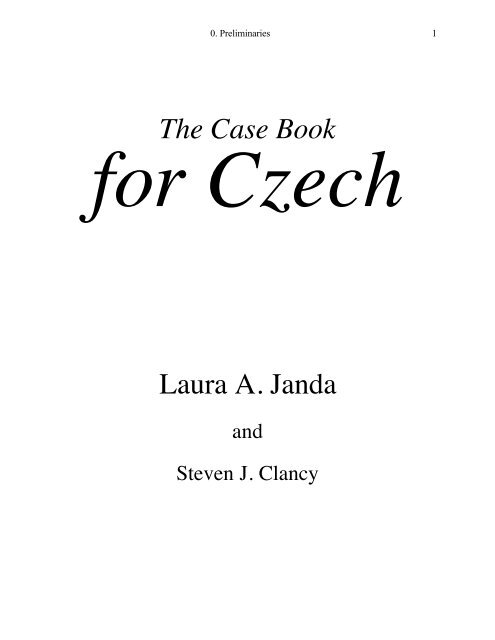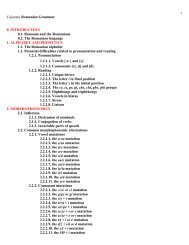The Case Book Laura A. Janda - SeeLRC
The Case Book Laura A. Janda - SeeLRC
The Case Book Laura A. Janda - SeeLRC
You also want an ePaper? Increase the reach of your titles
YUMPU automatically turns print PDFs into web optimized ePapers that Google loves.
0. Preliminaries 1<br />
<strong>The</strong> <strong>Case</strong> <strong>Book</strong><br />
for Czech<br />
<strong>Laura</strong> A. <strong>Janda</strong><br />
and<br />
Steven J. Clancy
0. Preliminaries 2<br />
Preliminaries<br />
PRELIMINARIES 1 — <strong>The</strong> mission of this book<br />
Na dveřích do Beátina budoáru byla velká obdélníková samolepka s nápisem PRIVATE a asi<br />
tucet starých vodových obtisků s portréty různých hudebních skupin, přičemž četné rýhy na mnoha<br />
z nich svědčily o marných pokusech je seškrábat. Když jsem se ani po třetím zaklepání nedočkal<br />
žádné slyšitené výzvy, se slovy Mohu dál? jsem vstoupil.<br />
V pokoji panovalo dusné a temné přítmí, neboť brokátové závěsy na oknech propouštěly opravdu<br />
jen minimum světla. Chvíli mi proto trvalo, než jsem se zorientoval: celou místnost rodělovala<br />
dlouhá, asi půldruhého metru vysoká knihovna, která vybíhala z protější stěny a přímo proti<br />
vstupním dveřím byla po způsobu lodních přídí zakončena barevnou dřevěnou figurou mořské<br />
panny, jejíž poněkud expresivně vztyčené paže sloužily jako šatní věšák. V menší části pokoje byl<br />
jednoduchý pracovní kout s psacím stolem, zavaleným knihami a papíry. Zbylým dvěma třetinám<br />
dominovala originální rohová sedací sestava, zahrnující dvě obrovské amorfní hromady jakýchsi<br />
buřtovitých polštářů, dva nízké, už napohled vratké kožené taburety a jedno autentické zubařské<br />
křeslo. Roli tradičního konferenčního stolku zajímavě suplovala polovina ropného barelu firmy<br />
Texaco, stojící uprostřed čtvercového koberečku s orientálními vzory. V rozích stěn byly zavěšené<br />
velké černé reproduktory a mezi zatemněnými okny visela polystyrénová deska se spoustou ručně<br />
psaných poznámek a výstřižků z revue Vokno. Povlečení rozestlané postele, v níž čelem ke zdi ležela<br />
Beáta, bylo ovšem smutně tuctové.<br />
On the door to Beáta’s boudoir there was a large rectangular decal saying PRIVATE and about<br />
a dozen old stickers with the pictures of various bands, although numerous scratches on many of<br />
them attested to vain attempts to scrape them off. When even after knocking three times I didn’t<br />
receive any audible response, I said May I come in? and entered the room.<br />
A stuffy dark gloom pervaded the room because the brocade window dressings let in very little<br />
light, and it took me a while to get oriented. <strong>The</strong> whole room was divided by a long bookcase about<br />
five feet high, running from the opposite wall all the way to the door, where, like the bow of a ship, it<br />
was appointed with a painted mermaid, whose oddly expressive upraised arms served as coathooks.<br />
<strong>The</strong>re was a workspace in the smaller part of the room, with a desk heaped with books and<br />
papers. <strong>The</strong> remaining two-thirds of the room were dominated by a creative corner seating<br />
arrangement, consisting of two enormous amorphous piles of sausage-shaped cushions, a pair of<br />
rickety-looking leather footstools and an authentic dentist’s chair. Substituting for a traditional<br />
coffee-table was half a Texaco oil barrel standing in the middle of a square rug with an oriental<br />
pattern. Large black speakers were suspended in the corners, and between the darkened windows<br />
hung a styrofoam board with lots of hand-written notes and clippings from Vokno review. <strong>The</strong><br />
sheets of the unmade bed, where Beáta was lying facing the wall, were however depressingly<br />
ordinary.<br />
—from Výchova dívek v Čechách, by Michal Viewegh<br />
Open a Czech-English dictionary and you will find the meanings of every kind of word. 1 Many<br />
dictionaries will even list translations for prefixes. But you won’t find meanings for cases in your<br />
trusty dictionary. If you are lucky, your textbook might list some meanings for each case, but<br />
chances are these entries will look rather like the disheveled décor of Beáta’s room, and be just as<br />
appealing. Take the dative case, for example. Your grammar book might tell you that the dative is<br />
used in the following contexts: for the indirect object; with the prepositions k ‘toward’ and proti<br />
‘against’; with certain verbs such as odpovědět ‘answer’, chybět ‘be missing’, gratulovat<br />
‘applaud’, zaplatit ‘pay’, podobat se ‘be similar to’, pomoci ‘help’, patřit ‘belong to’, věřit<br />
1<br />
Traditional explanations of Czech cases usually look like random lists of items.
0. Preliminaries 3<br />
‘believe’, škodit ‘harm’, pomstít se ‘take revenge on’, divit se ‘be surprised at’, závidět ‘envy’,<br />
vévodit ‘rule over’; in impersonal expressions of age and comfort such as Je mi dvacet let/zima [Is<br />
me-DAT twenty-NOM years-GEN/cold] ‘I’m twenty years old/cold’. <strong>The</strong>re’s no obvious pattern<br />
in such an explanation, and it doesn’t prepare you to predict what other words might be associated<br />
with the dative, or to interpret a sentence like Miminko nám pláče v noci [Baby-NOM us-DAT<br />
cries in night-LOC] ‘Our baby cries at night’. <strong>The</strong> incoherent assortments of case usage offered<br />
up in this fashion are incomplete and suggest no logical motive. <strong>The</strong>re is also no logical motive for<br />
the student to try to learn them, since they don’t make sense. <strong>The</strong> only choice seems to be to<br />
memorize lists of case uses, and this proves to be a formidable if not impossible task, since it is<br />
exceedingly difficult to assimilate information if it looks to you like just so much nonsense.<br />
But entering the realm of Czech case meanings need not be as disheartening or disorienting as<br />
going into the room of a sloppy, spoiled teenager. 2 <strong>The</strong> goal of this text is to show you that there<br />
are patterns to case usage that make sense and can be learned fairly easily. This book can be used<br />
by students at any level of study, from beginner through advanced.<br />
<strong>The</strong> meanings of the grammatical cases are probably the biggest obstacle faced by Englishspeaking<br />
students trying to learn Czech. 3 Even advanced learners will often run into sentences they<br />
can’t interpret. Students often know plenty of vocabulary and how to find unfamiliar words in the<br />
dictionary, and maybe they can even figure out what cases all the nouns, pronouns, and adjectives<br />
are in, but if they cannot figure out what the cases mean, the meaning of a sentence remains a<br />
mystery.<br />
<strong>The</strong> meaning of a sentence is a product of two interdependent forces: the words it contains, and<br />
the relationships they have to each other. 4 In English these relationships are usually expressed by<br />
means of word order and prepositions, but in Russian this job is done by case. <strong>The</strong> words are fairly<br />
self-contained and concrete, since they can exist by themselves, outside of any sentence. <strong>The</strong><br />
relationships that hold among words are relatively abstract and largely dependent upon context. <strong>The</strong><br />
relationships themselves can be likened to a bare conceptual structure that is fleshed out by the<br />
actual words chosen. You can compare this to the concept sandwich, which indicates a set of<br />
relationships among bread, spreads, and fillings. By itself, sandwich is abstract, and if somebody<br />
asked you to “make a sandwich”, you would probably ask for more information. If instead the<br />
request sounded something like “give me an open-faced turkey sandwich on rye with lettuce,<br />
tomato, and mustard, hold the mayo”, you would find that more satisfactory, because you would<br />
know both the relationship (sandwich) and the specific items in that relationship (one slice of rye,<br />
mustard [not mayonnaise] for spread, filling of turkey, lettuce, and tomato).<br />
Our culture has some abstract relationships that can’t be expressed in a single word, or even in<br />
a common expression. 5 Take for example the various types of games that involve two teams of<br />
people, each of which tries to control the movement of a round object into a space belonging to<br />
another team. Variations in the type of object, parts of body or implements used to move it, playing<br />
environments, rules, etc. yield specific games such as basketball, football, soccer, volleyball, field<br />
hockey, ice hockey, lacrosse, rugby, water-polo, tennis, and ping-pong. <strong>The</strong> abstract relationship that<br />
holds among all the players, objects, playing environments, and rules is so familiar that it is<br />
transparent to us. We don’t even think about it, and we apply it effortlessly even when we encounter<br />
a new game we haven’t seen before. Now, imagine that there are some people who live in a radically<br />
different culture, where there are no such sports. If you led them onto a lacrosse field and handed<br />
them some sticks and a ball, they would be utterly clueless. Without any extra help, it’s extremely<br />
unlikely that these people would start playing anything remotely like lacrosse. <strong>The</strong> sticks might<br />
seem handy for gathering apples from some nearby trees, and maybe the ball could serve as the<br />
head of a child’s doll or ritual effigy. Goodness knows what they would make of the goals.<br />
Nobody ever explained to you the principal relationship behind lacrosse or all the other games<br />
that work the same way. <strong>The</strong>y didn’t have to. You saw plenty of examples all around you and<br />
2<br />
This text explains the coherent patterns of case meanings and can be used at any level of study.<br />
3<br />
Why learning the meanings of Czech cases is an obstacle to students.<br />
4<br />
Czech cases show the relationships between words in a sentence.<br />
5<br />
Understanding Czech cases is like understanding how a game structures play.
0. Preliminaries 4<br />
internalized the principle without even thinking about it. In order to gain the kind of understanding<br />
you have for such games, newcomers who have never been exposed to such an idea will need an<br />
explanation, not just of the principle itself, but of how it functions in various actual games. <strong>The</strong><br />
situation of a student learning Czech is very similar to the culture-shock of these outsiders. Until<br />
you get acculturated to the games Czechs play with their cases, it is impossible for you to interpret<br />
and manipulate Czech sentences the way that Czechs do. <strong>The</strong> objective is to make you into effective<br />
players of the case game. <strong>The</strong>re are challenges to face, as in any game, but they are part of the sport,<br />
and the rewards of really mastering the language far outweigh the difficulties.<br />
If a Czech asked you to explain the meaning of the English preposition for, you might be<br />
surprised and frustrated by the difficulty of this task. Even if you couldn’t give your Czech friend a<br />
satisfactory answer, that wouldn’t mean that for doesn’t mean anything or that there are lots of<br />
different fors that are not related to each other in any systematic way. Intuitively you sense that for<br />
does mean something and that all uses of for relate to that meaning. <strong>The</strong> same goes for Czechs and<br />
cases: they may not be able to tell you why all those different verbs take the dative case, but they<br />
have an intuitive sense that the dative case does mean something and the contexts in which the dative<br />
appears has to do with that meaning.<br />
PRELIMINARIES 2 — How information is presented in this book<br />
This book will present to you the basic meanings of each case, and it will also show you all the<br />
specific uses and how they relate to the basic meaning. 6 To help you focus on the cases and their<br />
meanings, all examples are presented with both a word-by-word gloss and a smooth translation.<br />
<strong>The</strong> cases will be marked with abbreviated tags in the word-by-word gloss: NOM for nominative,<br />
GEN for genitive, DAT for dative, ACC for accusative, VOC for vocative, LOC for locative (also<br />
known in some textbooks as “prepositional”), and INST for instrumental. <strong>The</strong> Czechs themselves<br />
use three systems of labels for their cases (which they call pády), all of which they learn in school: a<br />
numeric system, a system based on the case forms of the pronouns kdo ‘who’ and co ‘what’, and<br />
the Latin names of the cases (which are basically the same as our names, with adjustments made for<br />
Czech spelling). 7 Here is a comparison of the three systems:<br />
Notation in this<br />
book<br />
Numeric system “kdo - co” system Czech versions of<br />
Latin names<br />
NOM 1. (první pád) kdo - co nominativ<br />
GEN 2. (druhý pád) koho - čeho genitiv<br />
DAT 3. (třetí pád) komu - čemu dativ<br />
ACC 4. (čtvrtý pád) koho - co akuzativ<br />
VOC 5. (pátý pád) volání, ‘calling’ vokativ<br />
LOC 6. (šestý pád) (o) kom - (o) čem lokativ/lokál<br />
INST 7. (sedmý pád) kým - čím instrumentál<br />
Each case will further be associated with two labels, one of which is a word and the other a diagram.<br />
For example, the instrumental will look like this:<br />
I<br />
INSTRUMENTAL: A MEANS<br />
6<br />
<strong>The</strong> notation and presentation of case in this book.<br />
7<br />
How the Czechs label their cases by names and numbers.
0. Preliminaries 5<br />
Both the word and the diagram are meant to suggest the basic meaning of the case, to give you a<br />
handle to grip your memory to. <strong>The</strong>y are not definitions, nor do they imply that Czechs have such<br />
labels or think in pictograms or anything of that sort. <strong>The</strong>y are merely a reference point for the<br />
process of working through the meanings. Both the word and the diagram focus only on the<br />
meaning of the case itself, which is usually embedded in a sentence that uses several cases. For<br />
example, a sentence like the following could be represented by a larger diagram in which<br />
INSTRUMENTAL: A MEANS would be only a component:<br />
Řezník krájel maso nožem.<br />
[Butcher-NOM sliced meat-ACC knife-INST.]<br />
<strong>The</strong> butcher sliced the meat with a knife.<br />
N<br />
I<br />
A<br />
However, such diagrams would quickly become clumsy and distracting. We will focus on only one<br />
case at a time instead of diagramming entire sentences this way.<br />
Most cases have submeanings related to the basic meaning; a double colon will be used to refer<br />
to a specific submeaning:<br />
I<br />
INSTRUMENTAL:: A LABEL<br />
When there are submeanings, they will be arranged in a network to show how they are related to<br />
each other and to the basic meaning. For example, the network of the instrumental looks like this:<br />
A MEANS<br />
A LABEL<br />
AN ADJUNCT<br />
A LANDMARK<br />
<strong>The</strong> object of this text is not to teach you the case endings for nouns, adjectives, pronouns, and<br />
numerals. 8 Working through these materials will certainly reinforce your knowledge of what these<br />
paradigms look like, but there are many other books and materials for achieving that goal. Drilling<br />
8<br />
This book focuses on case meaning, not endings; tables of endings appear in every chapter and in the appendix.
0. Preliminaries 6<br />
the endings would distract you from concentrating on the meanings. However, if you want to review<br />
the case endings at any time, there are tables in the appendix giving complete declensions for your<br />
reference, and shortened tables specific to each given case are at the beginning of each chapter.<br />
In addition to basic meanings and submeanings, metaphor plays an important role in case<br />
meaning. 9 <strong>Case</strong> meaning takes as its point of departure the relationships that hold among physical<br />
objects placed or moving in space. <strong>The</strong>se relationships can be metaphorically transferred to other<br />
domains such as time or social interaction, just as we see in English:<br />
English on in space: I already have dinner on the table.<br />
English on in time: I have a doctor’s appointment on Monday.<br />
English toward in space: <strong>The</strong> troops are advancing toward the border.<br />
English toward in social interaction: That director is favorably inclined toward<br />
English actresses.<br />
In these examples, time and social interaction are treated as if they were physical spaces. For the<br />
most part, Czechs use these metaphors in ways very similar to those familiar from English, though<br />
some uses might surprise you. Throughout the text mention is made of meanings that are extended<br />
to domains other than space. <strong>The</strong>se metaphorical extensions, in conjunction with items specific to<br />
certain contexts, such as numerals, indirect experience, certain verbs and prepositions, are<br />
responsible for the more specific meanings that you will find nested under the basic meanings and<br />
submeanings.<br />
<strong>The</strong>re are also relations that hold between the cases. 10 It is not essential for you to memorize or<br />
appreciate these relations at this point, but since these relations have some influence on the<br />
descriptions they are given, a brief overview is in order. This overview is purely for purposes of<br />
general orientation; the statements it makes are abstract and will probably make more sense to you<br />
after you have completed the text. <strong>The</strong> nominative basically names an item, and has no particular<br />
designation. <strong>The</strong> instrumental is relatively peripheral to the nominative, and names an item through<br />
which something happens; it is a mere conduit, envelope, or accompaniment for something else.<br />
Both the accusative and the dative signal direction; the accusative is the destination for some item or<br />
activity, and the dative, relatively more peripheral, is a receiver or experiencer of some item or<br />
activity, usually capable of producing some further action in response. <strong>The</strong> sectioning of a part from<br />
its source is expressed by the genitive; more abstractly such sectioning can involve background<br />
elements of the setting, expressed by the locative. <strong>The</strong> vocative is very different from the other cases<br />
since it is not really a part of a sentence, but it does overlap somewhat with the naming function of<br />
the nominative.<br />
Most of the people using this book are probably already very familiar with the fact that Czech<br />
exists in two standard versions: a literary norm, known as Literary Czech, and a spoken language,<br />
known as Colloquial Czech (better thought of as two ends of a continuum of language use). In<br />
order to become proficient in Czech, a learner must master both versions, and this book<br />
acknowledges and presents examples of both Literary Czech (LCz) and Colloquial Czech (CCz).<br />
All case phenomena specific to Colloquial Czech, as well as all examples containing Colloquial<br />
Czech features will be designated CCz. <strong>The</strong> designation LCz will be used only when it is necessary<br />
to emphasize an exclusively literary case phenomenon or very bookish example.<br />
You will notice that the examples in this book are very different from the examples you have<br />
seen in other textbooks. 11 That is because these are not textbook examples; not a single one of them<br />
was cooked up for this book. Our examples have been gathered from literature, periodicals, the<br />
Czech National Corpus, and the internet. Trying to learn Czech cases from traditional textbook<br />
examples is a little like trying to learn about the water cycle by studying the steam in your<br />
bathroom. It leads to the syndrome described at the beginning of this section, where you know all<br />
the words and endings, but still can’t make sense of the sentence. Most learners hit this plateau at<br />
9<br />
Spatial relations and metaphor motivate case meaning.<br />
10<br />
<strong>The</strong> relationships between the cases.<br />
11<br />
<strong>The</strong> examples in this book are real, not concocted.
0. Preliminaries 7<br />
some point, and if you’re a fast learner, you risk getting stuck there even sooner. Rather than being<br />
contrived and antiseptic, the examples in this book and exercises will expose you to the cases as<br />
they really are, raw and unadulterated. This means that the examples will be somewhat messier than<br />
the ones you are used to seeing. But hopefully this guided tour of case realia will help to make your<br />
transition from language study to language use a confident, seamless stride rather than a desperate<br />
leap into a void.








